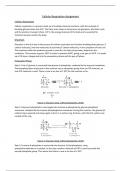Cellular Respiration Assignment
Cellular Respiration
Cellular respiration is a process made up of multiple chemical reactions, with the end goal of
breaking glucose down into ATP. The three main steps in this process are glycolysis, the Krebs cycle
and the electron transport chain. ATP is the energy molecule of the body and is essential for
chemical reactions within the body.
Glycolysis
Glycolysis is the first step in the process of cellular respiration and involves breaking down glucose, 6
carbon molecule), into two molecules of pyruvate (3 carbon molecule), in the cytoplasm of each cell.
The reactions which the product pyruvate is used for, the fates of pyruvate, depend on the
conditions. This process requires 2ATP in order to produce 4ATP, giving a net gain of 2ATP. It is made
up of 10 steps, categorised into the preparatory phase and the pay-off phase.
Preparatory Phase:
Step 1: First, D-glucose is converted into glucose-6-phosphate, catalysed by the enzyme hexokinase.
The phosphorylation of glucose in this reaction uses a phosphate group from an ATP molecule, so
one ATP molecule is used. There is now a net loss of 1 ATP for the reaction so far.
Figure 1: Glycolysis Step 1 (Microbiologyinfo, 2019)
Step 2: Glucose-6-phosphate is rearranged into fructose-6-phosphate by glucose phosphate
isomerase, catalysed by the enzyme phosphoglucose isomerase. During the reaction, the glucose (6-
carbon) ring is opened and closes again to form a 5-carbon ring, fructose, with the first carbon now
outside of the ring.
Figure 2: Glycolysis Step 2 (Microbiologyinfo, 2019)
Step 3: Fructose-6-phosphate is converted into fructose-1,6-bisphosphate, using
phosphofructokinase as a catalyst. In this step, another molecule of ATP is used to provide the
second phosphate group. This means that there is now a net loss of 2 ATP.
, Figure 3: Glycolysis Step 3 (Microbiologyinfo, 2019)
Step 4: In this step, the enzyme aldolase catalyses the reaction of fructose-1,6-bisphosphate into
two sugar molecules, dihydroxyacetone phosphate and glyceraldehyde 3-phosphate, which are
isomers of each other.
Figure 4: Glycolysis Step 4 (Microbiologyinfo, 2019)
Step 5: Dihydroxyacetone phosphate (DHAP) and glyceraldehyde 3-phosphate (GAP) are rapidly
inter-converted, using the enzyme triosephosphate isomerase as a catalyst. Only GAP is used in the
rest of the glycolysis reaction, so all DHAP molecules produced are converted into GAP by the
triosephosphate isomerase enzyme, to be used later in the process.
Figure 5: Glycolysis Step 5 (Microbiologyinfo, 2019)
Pay-Off Phase:
, Step 6: Next, the enzyme glyceraldehyde-3-phosphate dehydrogenase catalyses the phosphorylation
of glyceraldehyde 3-phosphate, to produce 1,3-bisphosphoglycerate. To do this, first GAP is oxidised
by the nicotinamide adenine dinucleotide (NAD) coenzyme and then the molecule is phosphorylated
by a free phosphate group addition.
Figure 6: Glycolysis Step 6 (Microbiologyinfo, 2019)
Step 7: A phosphate group is transferred from 1,3-bisphosphoglycerate to ADP to form ATP and 3-
phosphoglycerate, catalysed by phosoglycerate kinase, and 1,3-bisphosphoglycerate is converted to
3-phosphoglycerate. There are two molecules of 1,3-bisphosphoglycerate which are converted
during this step, each producing one molecule of ATP, so there are two molecules of ATP produced
in total. This means that the overall reaction now has a net zero of ATP molecules.
Figure 7: Glycolysis Step 7 (Microbiologyinfo, 2019)
Step 8: In the next step, a phosphate group from 3-phosphoglycerate is relocated from the third
carbon to the second carbon, forming 2-phosphoglycerate, using the enzyme phosphoglycero
mutase.
Figure 8: Glycolysis Step 8 (Microbiologyinfo, 2019)
Step 9: The enzyme enolase catalyses the dehydration of 2-phosphoglycerate to from
phosphoenolpyruvic acid (PEP), removing one water molecule.




